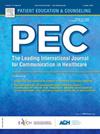“My child needs a chance and a choice to talk about their pain”: Parents’ experiences and perspectives of pain communication in paediatric rheumatology.
IF 2.9
2区 医学
Q2 PUBLIC, ENVIRONMENTAL & OCCUPATIONAL HEALTH
引用次数: 0
Abstract
Objective
To investigate parents’ experiences and perspectives about pain communication with healthcare professionals in paediatric rheumatology.
Methods
Data were collected using semi-structured telephone interviews with parents of children/adolescents recruited from three UK tertiary paediatric rheumatology centres. A framework analysis was used to characterise parents’ experiences and perspectives.
Results
Eighteen parents participated. Their children had a median age of 13 years (SD= 3.16 years, Range= 6–16 years, 55 % male), with diagnoses of chronic primary pain (e.g. Ehlers Danlos syndrome/Hypermobility) and chronic secondary pain (e.g. Juvenile Idiopathic Arthritis). Data were organised into four themes: 1) Parents’ active role in pain communication, 2) Building blocks of effective pain communication, 3) Stark realities of pain communication and 4) Purpose for prioritising pain communication. Parents discussed their role in advocating for their child and encouraging their child to communicate about their pain. Parents reported experiences of unsatisfactory pain management advice being provided and frequent experiences of their child’s pain being dismissed by healthcare professionals.
Conclusion
Findings emphasise several advantages of involving parents in communication about their child’s pain, as well as a range of challenges in pain communication with healthcare professionals from parent perspectives.
Practice implications
These findings inform recommendations to facilitate more effective pain communication approaches which include parents in the future.
“我的孩子需要一个机会和选择来谈论他们的疼痛”:儿童风湿病学中疼痛沟通的父母经验和观点。
目的了解儿童风湿病患儿家长与医护人员进行疼痛沟通的经验和观点。方法采用半结构化电话访谈的方式收集来自英国三所三级儿科风湿病中心的儿童/青少年家长的数据。一个框架分析被用来描述父母的经历和观点。结果共有18名家长参与。他们的孩子中位年龄为13岁(SD= 3.16岁,范围= 6-16岁,55% %男性),诊断为慢性原发性疼痛(如Ehlers Danlos综合征/活动过度)和慢性继发性疼痛(如青少年特发性关节炎)。数据分为四个主题:1)父母在疼痛沟通中的积极作用;2)有效疼痛沟通的组成部分;3)疼痛沟通的严峻现实;4)疼痛沟通优先级的目的。父母们讨论了他们在支持孩子和鼓励孩子交流他们的痛苦方面所扮演的角色。父母报告的经验,不满意的疼痛管理建议被提供和频繁的经验,他们的孩子的疼痛被驳回的医疗保健专业人员。结论研究结果强调了让父母参与孩子疼痛沟通的几个优势,以及从父母的角度与医疗保健专业人员进行疼痛沟通的一系列挑战。实践意义这些发现为今后包括父母在内的更有效的疼痛沟通方法提供了建议。
本文章由计算机程序翻译,如有差异,请以英文原文为准。
求助全文
约1分钟内获得全文
求助全文
来源期刊

Patient Education and Counseling
医学-公共卫生、环境卫生与职业卫生
CiteScore
5.60
自引率
11.40%
发文量
384
审稿时长
46 days
期刊介绍:
Patient Education and Counseling is an interdisciplinary, international journal for patient education and health promotion researchers, managers and clinicians. The journal seeks to explore and elucidate the educational, counseling and communication models in health care. Its aim is to provide a forum for fundamental as well as applied research, and to promote the study of organizational issues involved with the delivery of patient education, counseling, health promotion services and training models in improving communication between providers and patients.
 求助内容:
求助内容: 应助结果提醒方式:
应助结果提醒方式:


